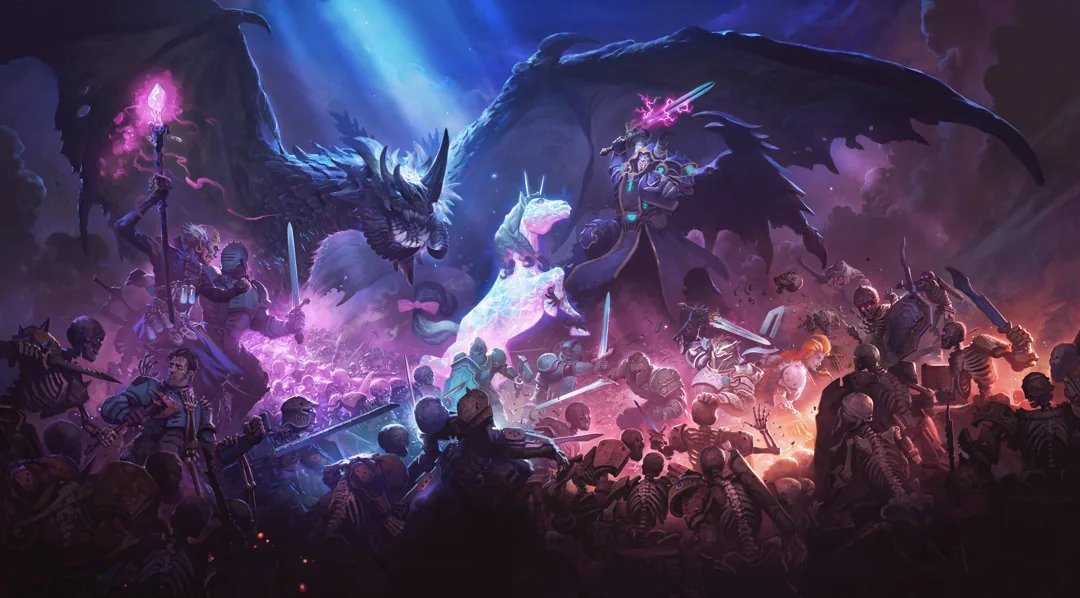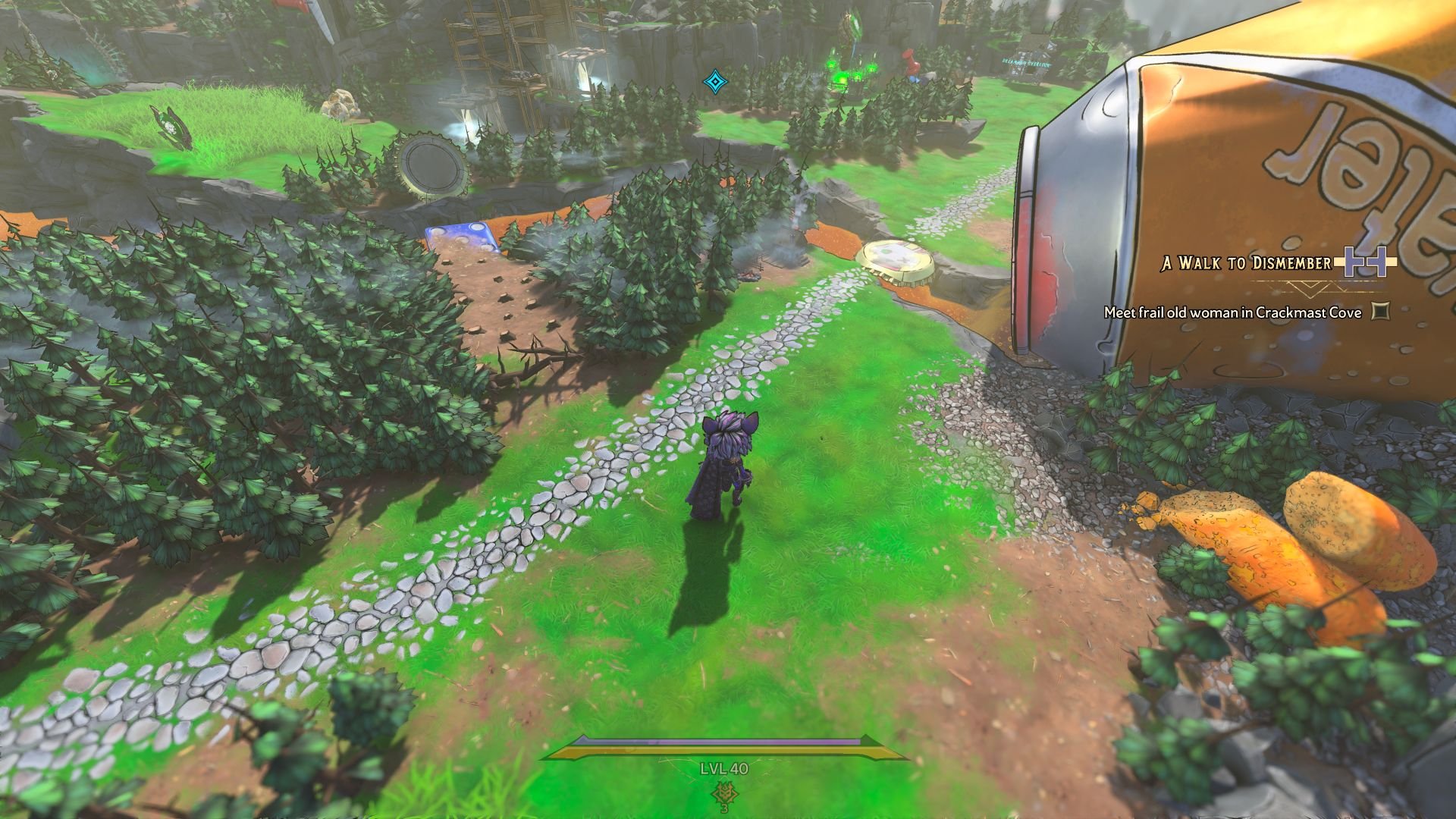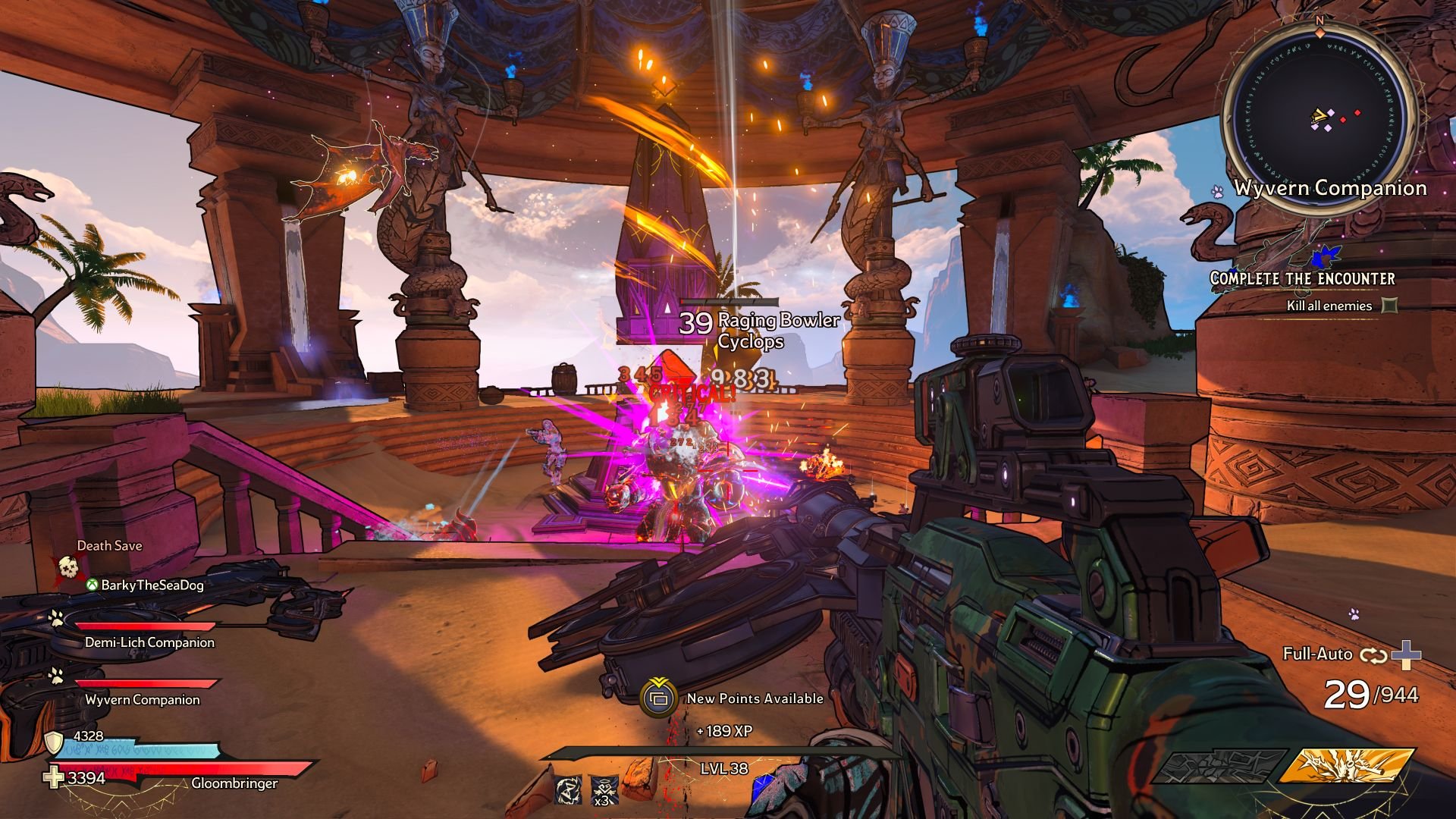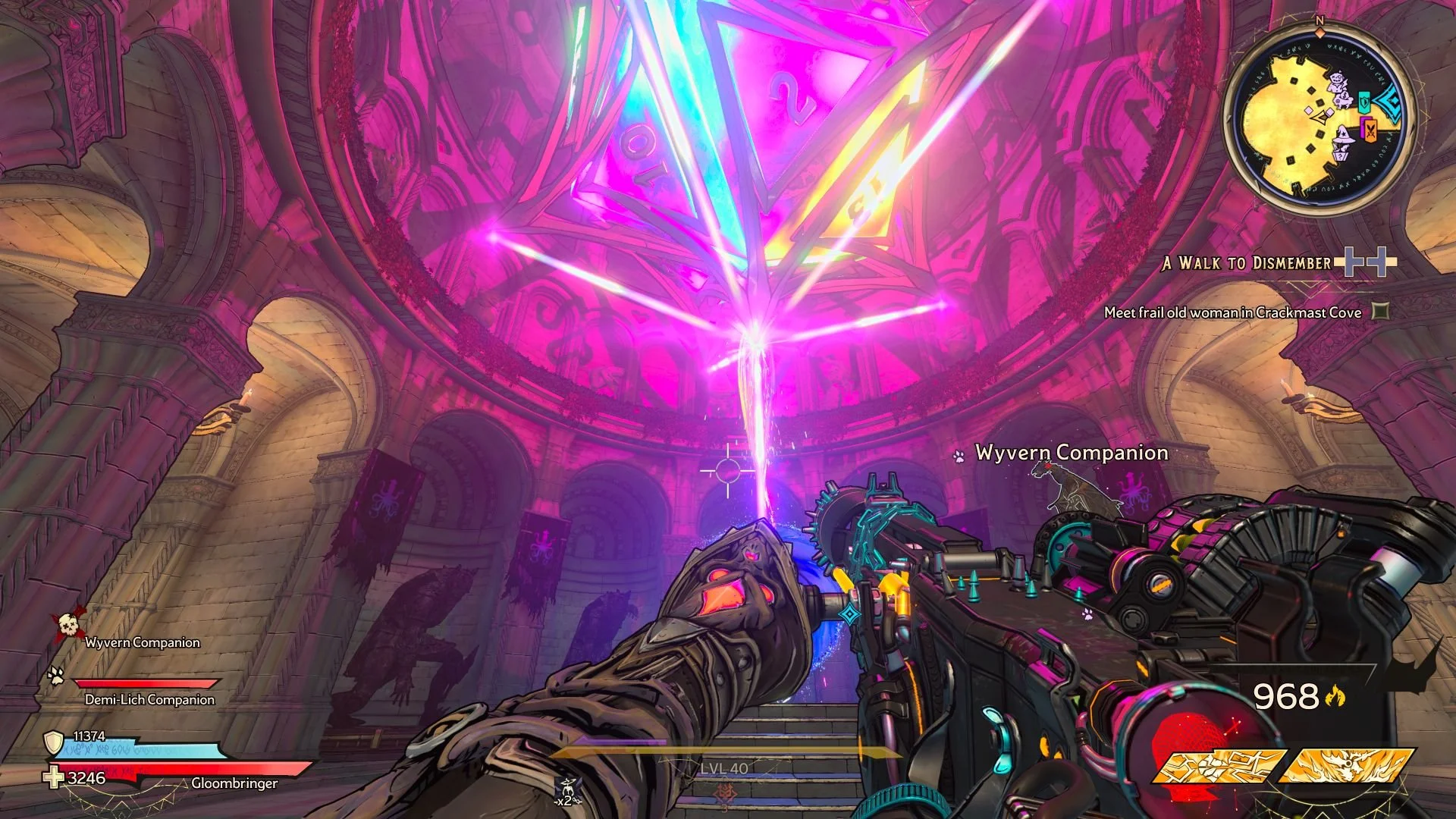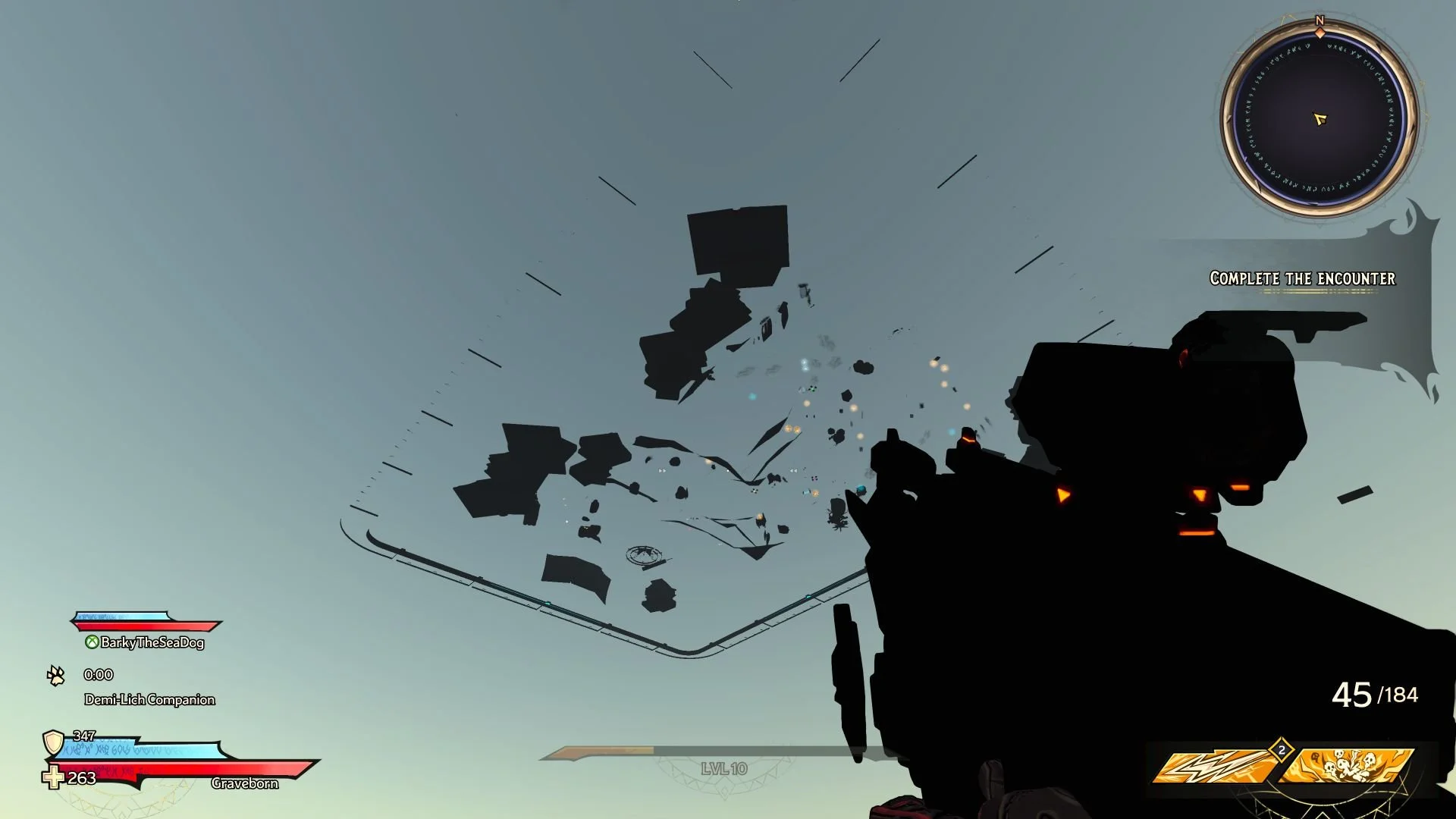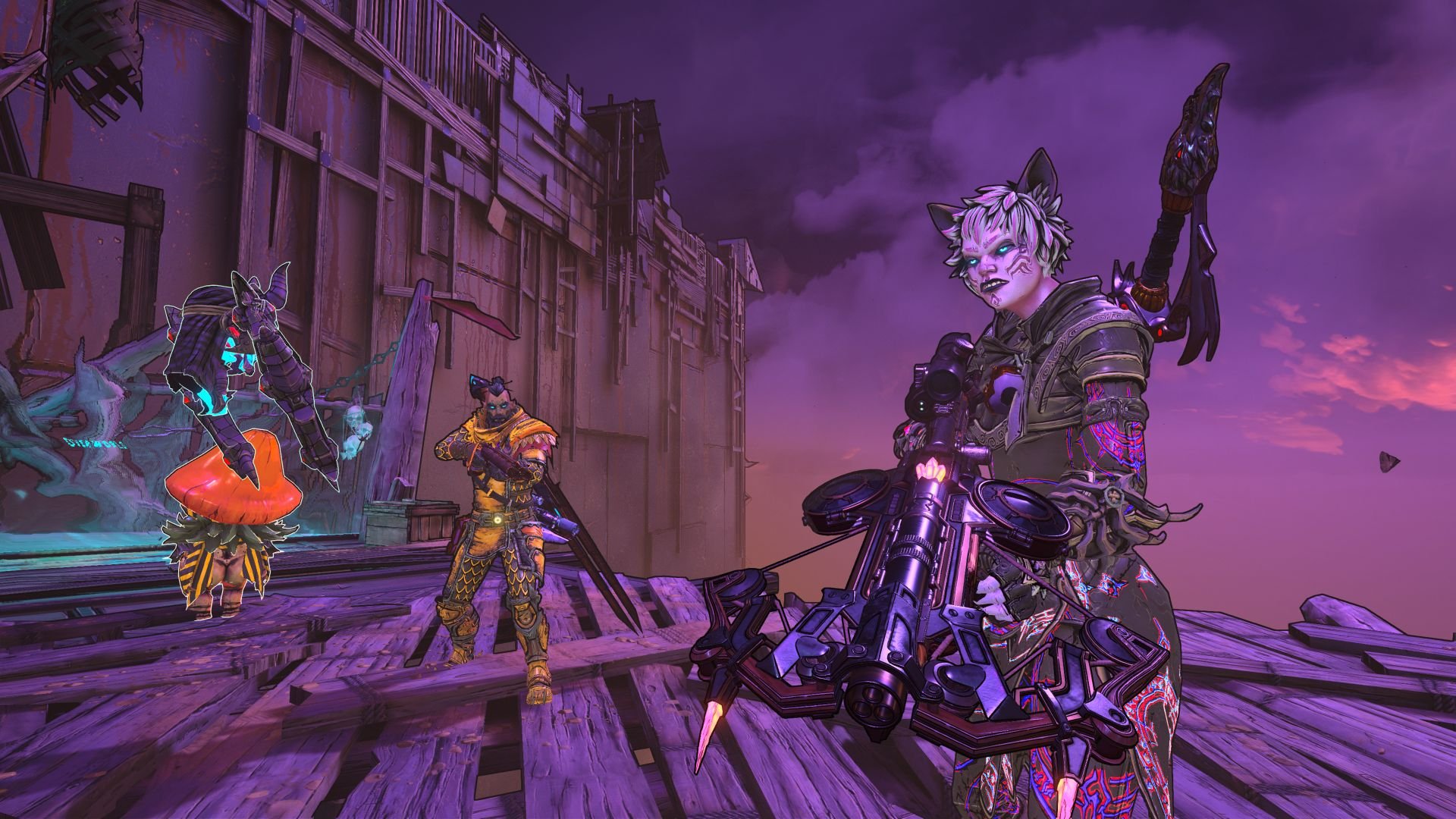Roll for slight Initiative.
When Tiny Tina's Wonderlands was first announced, I was rather excited to see Ashly Burch back in a larger capacity as the young bombastic and twisted Tiny Tina, especially since her role in Borderlands 3 was disappointingly minimal. However, part of me was cautious mainly due how to poorly written the third entry was, and I wasn’t too excited about seeing another disappointing entry in the series. However, for all its faults, of which there are several, Tiny Tina’s Wonderlands is surprisingly good, offering a fun take on a well-worn formula that despite all odds, can often kick ass.
Tiny Tina's Wonderlands is a fantasy take on the Borderlands formula, an extension of what started with the Assault on Dragon's Keep DLC for Borderlands 2, a content expansion that I still consider to be the best Borderlands has ever been. While Borderlands 3 suffered in a lot of ways, its gameplay and shooting mechanics were the best of the series, and when you combine that with what Assault on Dragon's Keep offered from a narrative angle, it makes for a very satisfying adventure, even if a few parts of the glue that hold it all together have started to show its cracks.
Gearbox’s latest is a small departure from the norm while also having that reskinned feeling of being a bit too close for comfort. So yes, this feels like a smaller budget adventure and a largely safe iteration of Borderlands 3 than a whole new thing. This causes this whole release to feel like a game built to fill the gap while we wait for the inevitable Borderlands 4. Locations are smaller than we’ve seen in the past, with a few exceptions, and there are fewer notable central characters to interact with, and very little in the way of any real innovation. The story is also considerably basic, and while there are a decent chunk of side quests to take on, they don’t really play much for variety and often come across as simply giving you places to go and things to shoot. Thankfully, the shooting is fun as hell, which has always been the driving force of this franchise.
Much like Assault on Dragon's Keep, Tiny Tina’s Wonderlands is built upon the bombastic youngster hosting a game of Bunkers and Badasses for you and your co-op friends, as well as for two non-playable characters who act as a voice in your ear as the pair can’t seem to fill out their character sheets properly and subsequently get benched. It is then up to you to venture forth, a newbie placed into Tina's world of wonder, a bastion for badassery, and whatever her twisted mind can come up with. Being based on D&D, a lot of what can happen in an actual game can and often does happen here. Events will occur around you via narration, seeing quiet fields suddenly spring to life with an army of skeletons, or maybe a character or two to seduce. While there are some solid examples to mention, a certain scenario regarding the team being more focused on a side character in a blue hat, than the NPC they are supposed to talk with, snowballed into easily the funniest moment in the game, and a prime example of the D&D roots being fodder for inspiration and hilarity.
Your goal across the Wonderlands is to confront and defeat the Dragon Lord, who is expertly voiced by Will Arnett. The catch? Well, the Dragon Lord apparently can also alter this reality, much to Tina’s surprise, and he occasionally looks to thwart your attempts by flipping the game on its head. The story does a good job at starting strong, with the first few hours building the Dragon Lord up, the threat he imposes, and what your mission then becomes. After that? Well, you'll have about 15 hours or so of not really that much, until the last few missions really pick up and offer some of the best storytelling the series has seen so far. It is a shame that such a solid portion of this game’s story is bland, almost as if they were saving all the best moments for the buildup and finale. That said, this adventure should run you about 20-25 hours to see it through, however, with only dipping my toe into some of the endgame content, I am pushing almost 40. Your time will also depend on how much of its side content you sample and whether or not you get bit by the adventuring bug and seek to uncover each and every map.
Previous Borderlands games have had pretty sizable supporting casts, from previous Vault Hunters, Mad Moxxi, Scooter, to even Handsome Jack. Sadly, there is not really much of a cast here beyond Tina and her two table-side companions. Sure, you’ll encounter a few series mainstays, but they are used so sparingly. There is also Lizzy at her bar, but honestly, she is merely a tour guide for things you’ll already know how to use than a fully fleshed-out personality. Tina’s companions; however, consist of Valentine and Frette, voiced by Andy Samberg and Wanda Sykes, respectively. Samberg pulls a lot from his Jake Peralta persona from Brooklyn 99 for much of his dialogue, even having a fun moment about character names and backstory. Wanda Sykes’s character, a robot of sorts, has some interesting moments, but much of her performance comes off very subdued for what we normally see of the comedian, and honestly, she sounds bored much of the time. I did find their use of simply being another voice in your ear to feel wasteful of their talents, but overall, I did enjoy the bulk of what they offered, even despite my issues with Sykes.
Ashly Burch has constantly been one of my favorite voice actors, and thanks to Mythic Quest, one of my favorite actors period. Her work on Hey Ash, Watcha Playin’ was the foundation for who Tina would eventually become, a role written for her by her brother Anthony when he led the writing team for Borderlands 2. Tina has been an iconic character for the series, and her emotional turn in Assault on Dragon’s Keep continues here and in some ways gives her closure for that arc through a few lines of dialogue that we are privy to. The story that started there continues and presents Burch with an opportunity to allow Tina to grow in a very touching moment.
While Ashly Burch is constantly great as Tina, the voices you can give your own characters vary from really bad to fairly tolerable. When I made my Graveborn, I chose “Strange A” as my character’s voice, since well, it sort of fit with the class. However; a few hours in, I realized I had made a huge mistake. One of her bits of banter is talking about how a map is a boring name and that “tapestry of worlds” had a better ring to it. Had this been a quick throwaway line, then ok, but it’s a long ordeal that I must have heard it almost every ten minutes. Swapping to Gruff or Clever removed that voice line and at most I had to deal with “I’m here to bring the arcane pain!” instead of a long spiel that I was consistently sick of hearing.
While Borderlands environments were connected via gates on the far reaches of most locations, Wonderlands tackles things a bit more D&D-like by having each location sprawled out across a giant crafted game table. This overworld is built from soda pop rivers, bottle caps for bridges, and a random cheddar puff blocking a road or two. The overworld is filled with caves, ruins, and a wealth of tall grass that can invite a random battle if the enemy that emerges from it catches up with you. While these battles can aid in earning some extra cash, or some loot at the end of your trouble, they eventually become a nuisance as they often roll out enemies too slow to act and you'll spend this short encounter constantly trying to track them down. Thankfully, you can smack at the emerging enemy before they can warp you into this fight, which is a godsend.
The overworld itself is loaded with quests and secrets alike, as well as Shrine Pieces that once collected, offer up permanent buffs such as more critical attack percentage, faster earnings for gold and experience, as well as being able to move around the table with a bit more pep. My favorite parts of the overworld are the homemade sections, or those that feel more “Tina made” and I wish the board was a bit more amateurish in its execution, selling that aspect a bit more. While I'll dive into the visuals a bit later, I do think the board could have seen a bit more polish in its details as I feel much of it feels far too basic in order to make the cel-shading pop, something that I can honestly say is the case for much of the game's environments as well. This game doesn’t really see any visual improvements from Borderlands 3 in any shape or form.
While a few areas will be a pretty sizable trek, there are few instances where the environments are massive in the space given to you in a specific spot. The lack of vehicles is certainly noticeable, and while they wouldn't make sense given the fantasy hook, I would have loved summonable mounts, maybe given to you from the “Catch a' Ride” fellow from the main series. Still, the maze-like environments work well, with a ton of verticality that benefits the size given to each location. Exploring much of that space will unlock secrets, such as several hidden gear chests or glowing yellow dice that will roll to determine your haul, a feature that was present in Assault on Dragon’s Keep, although in the form of a chest with dice on top of it.
The level variety is extremely solid, from pirate stationed beaches, long-forgotten ruins, goblin-infested swamps, to massive mushroom forests. While the pirate arc ran a tad too long for my liking, several locations, especially the last two or three, are some of the best Borderlands locations we've had yet. Each location is packed full of numerous references such as rampaging through Smurf village, into the belly of a dead whale to track down a wooden boy, to collecting four of five so-called mystical elements. There are a variety of other well-worn tropes such as a Battle of the Bands that will end exactly how you imagine it will, to planting a bean and then getting from it what you think is going to happen. Still, I enjoyed these moments since it fills the gap the main story takes for quite a while.
When Wonderlands was first announced, I was curious if the series would opt for leaning into the more magical side of spells and genre-appropriate weaponry, and focus less on guns and more on axes, swords, or staves. While the latter is here with swords, axes, and maces, and of course spells that you can wield to your heart’s content, Tiny Tina’s Wonderlands is still the RNG-flavored gun game that the series is known for. I mean, I was expecting it sure, but I sort of wish that the developer would have taken this as a chance to really shake it up instead of falling back on ol’ reliable. Regardless, the combination of guns and fantasy elements does succeed in making some incredible weapons of mass destruction and honestly, some of the best guns we’ve seen in the series full stop.
Each of the weapons you’ll wield are still stamped with its appropriate company names from Torgue, to Skulldugger, to Conjura, as well as Dahlia, which is borrowed from the series’ DAHL brand. Guns have traits that range from earning back health via damage to throwing out fire or lightning damage as well. Some traits work towards certain classes better than others or having its reload affect your melee damage or standard favorites like increasing your critical chance percentage. The types of weapons are still bizarre concoctions like we’ve seen before, but some come with genre flavors like guns that borrow a crossbow look or those that appear to be fueled by a small container of crystals. Melee weapons do borrow some of that metallic look as well, and some of the swords in this game are jaw-dropping in their designs even if the game’s melee isn’t more than simply swinging your weapon or a downward jump strike.
Your gear ranges from equipping rings, necklaces, and shields, as well as your overall armor, but only certain tiers actually change up the visual appearance of your character. Rings and necklaces essentially work towards buffing certain stats, whereas armor can often see benefitting a mixture of classes as you are eventually able to create a hybrid of two classes. These items benefit predictable traits like specific damage increase, faster reloading, to increasing your overall melee damage, so it essentially becomes a game of finding a stat you want to increase and doubling or sometimes tripling down on it.
The armor you find is a bit different as while it not only increases your class’s overall power, the higher tier pieces can also include active skills to boost your class with maybe a skill or two you either haven’t unlocked yet or maybe haven’t put many points into that specific skill. While you’ll have to pray to the RNG gods for a piece of armor that benefits the two classes you have mixed together as well as certain skills, it can and does sometimes happen, as I found a legendary piece of armor that did just that.
So, the classes here are a bit different than we’ve seen in the series before and this time, your class is not locked to a specific avatar as Wonderlands allows you to customize a whole character to your liking. The character editor is appropriately wild in ways that fits the series and hitting random after you’ve unlocked new cosmetic items after some 40 hours can create some truly bizarre styles. Still, once you’ve created your twisted and unique champion for the roleplaying adventure ahead, there are just as unique classes to choose from that range in a few creative and also sometimes disappointing skillsets, especially when it comes to the spells you can wield often coming across as much cooler abilities.
While one of the future DLC packs will add a whole new class, the game ships with six in total: Spellshot, Clawbringer, Spore Warden, Graveborn, Brr-Zerker, and Stabbomancer. While a few are pretty self-explanatory, they can still bend a bit of the genre rules that are usually applied to certain types. The Brr-Zerker is a frost-flavored class that is designed more around close combat than ranged, whereas the Spellshot is more designed around being at a distance as well as having the possibility of wielding two spells at once. The Stabbomancer is your typical rogue of sorts as they are akin to throwing spectral daggers for their special ability or simply turning invisible for a bit of stealth. The final three classes also come with a bit of assistance of having either a small little mushroom man, a wyvern, or a cackling Demi-Lich that floats around you. Each of these classes has a variety of different skills such as dark magic with the Graveborn, chilling cyclones or arrow barrages with the Spore Warden, to elemental hammer strikes with the Clawbringer.
It is when you mix and match these classes where the game gets very interesting. Take for example the Spore Warden’s Blizzard spell. It’s a cyclone that causes frost damage. So, if you were to level the Brr-Zerker as a secondary, you would see far more returns from combining the two classes for that spell specifically, to say nothing of the other benefits. However, in my case, I had the Graveborn and the Clawbringer, so I not only had my Demi-Lich, but the wyvern as well, causing untold chaos in the background as I sunk points into companion skills that gave them increased element power and abilities. Eventually, you can respec your secondary classes and find something else to work alongside your main, in case something didn’t vibe, or maybe you found a better build that complimented your central class choice.
In the mainline series, action skills were the core way where classes stood out from one another and that is still here in some ways. Sure, there are some of the skill tree abilities that do that as well, but it’s the action skills that were those defining differences. The action skills here can also feel like they are taking a back seat to the spells you can wield in certain ways. Some of these skills range from a whirlwind spinning attack, or a flashy blast of dark magic, to slamming a hammer into the ground and its pulsing field damaging anything it can touch. Most of these skills are decent but sometimes situational. I found I could select from the four I had across my hybrid Graveborn and Clawbringer and not really think much of it. My trusty spell; however, that was another story.
Wonderlands has a lot of spells and while some are fun to use like throwing down an acid-spitting hydra or a gelatinous cube, there are few that are going to stand out and become a permanent addition to your class, an ability so powerful that you’ll consider them more important than any weapon you’ll find. Some of these consist of pulling iced spikes up from the ground to one-shot most mobs, calling lighting down from the sky, to my personal favorite, the Quaking Sunder, that had me throwing out tunneling blasts that would destroy almost everything on the screen in one go. I also was a big fan of the meteor spells called Calamity that would reign down hell in one big firey blast. Now, each spell had variants that are determined by what the spell is called. Learning the differences will allow you to like a particular spell you maybe were not too keen on initially. I loved the Sunder I had at the start, where it would branch off into additional directions, but every other Sunder I found just wasn’t as fun. Finding the right one with the right stats is crucial to really see how beneficial they truly are. I do wish that spells had some sort of better descriptor to what they actually do, as sometimes it can be hard to tell what a specific spell does without spending the time to equip and test everything you’ve picked up. If spells had a preview window or a button to bring one up to show what it did, I think that would solve that issue I personally have with the colorful names and vague descriptors these abilities currently have.
Once you’ve saved the land from the threat of the Dragon Lord, you’ll be dipping into a loot loop with Wonderland’s endgame. Now, I am at odds with what it is and how it is presented. The Chaos Chamber is a series of random dungeon arena battles where you’ll choose different paths to determine whether you are looking to procure loot or crystals that in turn can provide you loot in the victory chamber. You can also use crystals to buff certain stats within rounds or choose more difficult paths to earn more crystals but have some sort of debuff or situational curse like having fallen enemies emit spectral spirits that will instantly down you if they touch you. There is a moderate variety here in where you’ll go and what you’ll fight, and you can also unlock Chaos Levels that increase the chances of better loot, more gold, as well as the final two tiers of loot in Chaotic and Volatile. Running Chaos Trials will increase your Chaos Rank, and running the Chaos Chamber runs will allow you to benefit from those increases in rank. It’s a really fun time with seeing old bosses perform new tricks and with how solid the shooting is here, you’ll be constantly having a great time.
Now, the only issue I have with the Chaos Chamber is how samey it can feel to the other dungeon runs you’ve done countless times before you hit endgame. Sure, the bosses can feel different here in how they are randomized, as well as the secret raid bosses only found within these runs, but I almost wish the host of the Chaos Chamber would have pulled a few tricks from Tina in changing up each arena with some slight spoken narrative, as she did with “..and suddenly there were skeletons!!” or some sort of indication that the narrator was pulling the strings. I think this would have made the loop feel more interesting than “Kill all enemies” or “Destroy the Dragon Statue”. Again, I love this mode and find it incredibly addicting, but it lacks the appeal of what made the campaign so special with Tina constantly shaking things up.
The last bit of endgame is reaching max level at 40 and unlocking Myth Rank. Now, I love the fact we can increase things like spell power or faster reloading, or even making my companions stronger, but the way in which Myth Rank works is kind of disappointing. Myth Rank has you rotating from four different categories; Archmage, Blademaster, Deadeye, and Druid. Druid will see you increase your loot luck, companion damage, and a few status effect skills, Archmage is things like spell damage, intelligence, as well as frost and fire damage. Blademaster and Deadeye are two sides of the same coin when looking to increase your melee or gun skills, as indicated by their names. Each title has a constellation that you work through that can be upgraded up to at least 10 or 20 depending on the skill. My issue with it is that you rotate to the next category after upgrading one, in a clockwise fashion. While it is nice to flex those points across a wide variety, it means you can’t really specialize in where you want to upgrade. I get what they were going for, but I don’t know if I really like this system yet; it might grow on me, but I doubt it.
Borderlands has a look and honestly, it hasn’t really changed or really seen a huge boost other than in resolution. Borderlands 3 looked fine, and certainly better in some ways than previous efforts, but like Wonderlands here, there are moments where some of the environments feel deliberately bland to make the cell-shading pop. Guns, characters, and the effects are all great and look incredibly solid, but as this game is shared across two generations of consoles, I don’t feel much was done to really set it apart and take advantage of the hardware. Again, this looks identical to Borderlands 3 but with the fantasy decor instead of the bandit infused wastelands we’ve seen before. I think this is the best-looking Borderlands game so far, but it’s more for aesthetic reasons than any boost in visuals that are noticeable.
During my roughly 40+ hours, I’ve experienced a TON of bugs from small things like the images of my weapons not appearing in my inventory, or when it says my teammate is dead but I see them running around, making it even more confusing when they are actually downed. While the last one was constant through my entire co-op playthrough, it’s the bigger stuff that just sucks the wind out its sails. I had constant issues with my quest log not showing anything, so figuring out what was a main quest and what was a side quest was impossible. I’ve had weapons disappear from my inventory entirely, but not as often as I fell through the map when trying to load back into the overworld. I would also be told that I unlocked a ring slot or a new weapon slot, but nope, those wouldn’t actually unlock until I either played for another hour or so or leveled up again. While I didn’t have problems connecting to a game or anything to do with the network, I did have the game freeze once, and of course, it had to be when I was just about to kill one of the secret raid bosses, kicking me out of the Chaos Chamber run and having to track them down all over again.
Borderlands is a franchise I adore, despite how badly written the third mainline game was. When Tiny Tina’s Wonderlands was announced, as I mentioned, I was hesitant about how good it could end up being. Thankfully, it’s remarkably solid, if a bit safe in what it aims to innovate on. It can feel like a reskin of Borderlands 3 in a fantasy wrapper and honestly, I’m fine with that to a point. I still despite the outdated menus we’ve had in the series for practically a decade so far as its cumbersome to navigate and using the left analog stick to move around the menu and junk items has almost cost me more legendaries than I want to mention. This is a great game with a lot of flaws, some mechanical, some technical, but most of them are simply design choices that come with the territory. I really want to love this game more than I do, because I honestly feel that Gearbox has something special here with the fantasy schtick. With the announcement of Tales from the Borderlands 2, and possibly Borderlands 4 on the horizon, not to mention DLC for this game, it’s a good time to be a Borderlands fan, but damn it, this series is in desperate need of innovation.
Bonus: Coiled Captors DLC Review
At the time of this review, Coiled Captors, the first DLC is out and it’s something I can’t recommend getting at this point. If you have the season pass or simply want more loot and new cosmetics, then this DLC is going to satisfy that to a point. Coiled Captors is a series of challenge rooms that eventually end in a boss encounter, if if the boss itself is a reskinned version of something we have already fought. There are some additional ways to get loot, but nothing I’ve had drop has been good whatsoever. The challenge is limited and will be increased weekly, which is a shame we can’t ground this out. The only benefit to this DLC so far is that locations within it are added to the room pool to pull from within the Chaos Chamber, giving us more locations to run the endgame with. As it stands, you can easily push through week one of this DLC is about 20 minutes, but honestly, It is just not worth it. 3/10 for the DLC.
Developer - Gearbox Software. Publisher - 2K Games. Released - March 25th, 2022. Available On - Xbox One, Xbox Series S/X, PS4, PS5, Windows. Rated - (T) Crude Humor, Blood, Suggestive Themes, Partial Nudity, Violence, Language.
Platform Reviewed - Xbox Series X. Review Access - Tiny Tina’s Wonderlands was purchased by the reviewer.

